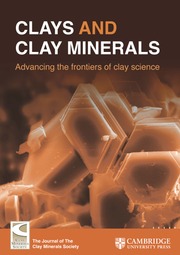Crossref Citations
This article has been cited by the following publications. This list is generated based on data provided by
Crossref.
Foster, R. H.
and
De, P. K.
1971.
Optical and Electron Microscopic Investigation of Shear Induced Structures in Lightly Consolidated (Soft) and Heavily Consolidated (Hard) Kaolinite.
Clays and Clay Minerals,
Vol. 19,
Issue. 1,
p.
31.
Diamond, Sidney
1971.
Microstructure and Pore Structure of Impact-Compacted Clays.
Clays and Clay Minerals,
Vol. 19,
Issue. 4,
p.
239.
O’Brien, Neal R.
1971.
Fabric of Kaolinite and Illite Floccules.
Clays and Clay Minerals,
Vol. 19,
Issue. 6,
p.
353.
McKyes, Edward
and
Yong, Raymond N.
1971.
Three Techniques for Fabric Viewing as Applied to Shear Distortion of a Clay.
Clays and Clay Minerals,
Vol. 19,
Issue. 5,
p.
289.
Osipov, Y. B.
and
Sokolov, B. A.
1972.
Quantitative characteristics of clays fabrics using the method of magnetic anisotropy.
Bulletin of the International Association of Engineering Geology,
Vol. 5,
Issue. 1,
p.
23.
Sheeran, DE
and
Krizek, RJ
1974.
A Spectrophotometric Technique for the Fabric Analysis of Monomineralic Kaolinitic Soils.
Journal of Testing and Evaluation,
Vol. 2,
Issue. 5,
p.
323.
1974.
Compaction of Argillaceous Sediments.
Vol. 16,
Issue. ,
p.
1.
1975.
Soil Properties and Behaviour.
Vol. 5,
Issue. ,
p.
431.
Martin, R. Torrence
and
Ladd, Charles C.
1975.
Fabric of Consolidated Kaolinite.
Clays and Clay Minerals,
Vol. 23,
Issue. 1,
p.
17.
Plançon, A.
and
Tchoubar, C.
1977.
Determination of Structural Defects in Phyllosilicates by X-Ray Powder Diffraction—II. Nature and Proportion of Defects in Natural Kaolinites.
Clays and Clay Minerals,
Vol. 25,
Issue. 6,
p.
436.
Tsidzi, K. E. N.
1987.
Foliation index determination for fine-grained metamorphic rocks.
Bulletin of the International Association of Engineering Geology,
Vol. 36,
Issue. 1,
p.
81.
1993.
Principles of Testing Soils, Rocks and Concrete.
Vol. 66,
Issue. ,
p.
657.
Baker, David W.
Chawla, Kanwarjit S.
and
Krizek, Raymond J.
1993.
Compaction fabrics of pelites: experimental consolidation of kaolinite and implications for analysis of strain in slate.
Journal of Structural Geology,
Vol. 15,
Issue. 9-10,
p.
1123.
Sachan, Ajanta
and
Penumadu, Dayakar
2007.
Identification of Microfabric of Kaolinite Clay Mineral Using X-ray Diffraction Technique.
Geotechnical and Geological Engineering,
Vol. 25,
Issue. 6,
p.
603.
Sachan, Ajanta
and
Penumadu, Dayakar
2007.
Effect of Microfabric on Shear Behavior of Kaolin Clay.
Journal of Geotechnical and Geoenvironmental Engineering,
Vol. 133,
Issue. 3,
p.
306.
Sachan, Ajanta
and
Penumadu, Dayakar
2009.
Effect of Shear Deformation on Microfabric of Clay Using XRD Technique.
Geotechnical and Geological Engineering,
Vol. 27,
Issue. 2,
p.
249.
Sachan, Ajanta
2013.
Effect of Intermediate Microfabric on Shear Strength and Strain Localization Response of Kaolin Clay Under Compression and Extension Loading.
Geotechnical and Geological Engineering,
Vol. 31,
Issue. 1,
p.
213.
Dowdy, R.H.
2015.
Soil Conditioners.
p.
25.
Low, Philip F.
2015.
Mineralogy in Soil Science & Engineering.
p.
1.
Jaradat, Karam A.
Darbari, Zubin
Elbakhshwan, Mohamed
Abdelaziz, Sherif L.
Gill, Simerjeet K.
Dooryhee, Eric
and
Ecker, Lynne E.
2017.
Heating-freezing effects on the orientation of kaolin clay particles.
Applied Clay Science,
Vol. 150,
Issue. ,
p.
163.


